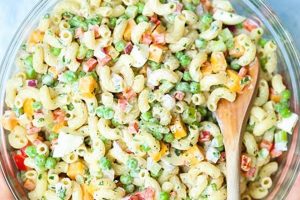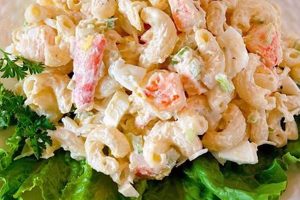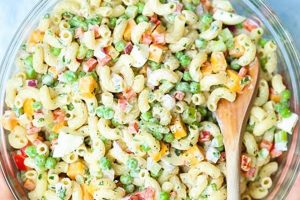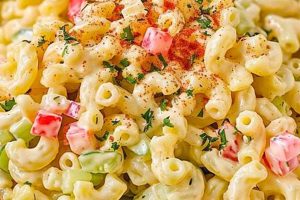A chilled pasta salad typically features cooked elbow macaroni, mayonnaise, and a variety of additions. Common ingredients include vegetables like celery, onion, and bell peppers, along with seasonings such as mustard, vinegar, salt, and pepper. Cheese, often cheddar, is a popular inclusion, contributing a creamy texture and savory flavor.
This dish offers a versatile and convenient meal option. Its adaptable nature allows for customization based on dietary preferences and available ingredients. The blend of carbohydrates, protein, and fats creates a satisfying dish, ideal as a side at barbecues, picnics, and potlucks, or as a light main course. Its relatively simple preparation and ability to be made ahead of time contribute to its popularity.
The following sections will delve into specific variations, offering detailed instructions for preparing this classic dish, exploring ingredient substitutions for dietary restrictions, and providing tips for optimal presentation and storage.
Tips for Exceptional Macaroni Salad
Elevating this classic dish requires attention to detail and a few simple techniques. These tips ensure optimal flavor, texture, and overall presentation.
Tip 1: Pasta Perfection: Cook pasta al dente for optimal texture. Overcooked pasta results in a mushy salad. Rinse cooked pasta under cold water to stop the cooking process and maintain firmness.
Tip 2: Cheese Selection: Sharp cheddar offers a robust flavor that complements the other ingredients, while milder cheeses like Colby or Monterey Jack provide a creamier texture. Consider incorporating crumbled or shredded varieties for optimal distribution.
Tip 3: Vegetable Enhancement: Fresh, crisp vegetables enhance both flavor and texture. Finely dice vegetables for even distribution throughout the salad. Blanching certain vegetables, such as broccoli or cauliflower, can enhance their color and tenderness while maintaining a crisp texture.
Tip 4: Mayonnaise Mastery: High-quality mayonnaise contributes significantly to the overall flavor. Experiment with different brands or consider making homemade mayonnaise for a richer, creamier texture.
Tip 5: Seasoning Secrets: A balanced blend of seasonings is crucial. Classic combinations include mustard, vinegar, salt, and pepper. Fresh herbs, such as dill or chives, can add a bright, fresh element.
Tip 6: Chilling Time: Allowing the salad to chill for at least two hours, or preferably overnight, allows the flavors to meld and develop fully. This chilling period also enhances the overall texture.
Tip 7: Presentation Prowess: Serve the salad in an attractive bowl. Garnishing with a sprinkle of paprika, chopped fresh herbs, or a few reserved cheese cubes enhances visual appeal.
By following these tips, one can create a truly exceptional macaroni salad that is both delicious and visually appealing. The careful selection of ingredients, proper cooking techniques, and attention to detail elevate this simple dish to a culinary masterpiece.
The following section offers a collection of variations on this classic recipe, providing further inspiration and opportunities for culinary exploration.
1. Elbow Macaroni
Elbow macaroni’s unique shape and texture make it the quintessential pasta for classic macaroni salad. Its curved tubes provide ample surface area for capturing dressing and clinging to other ingredients, contributing significantly to the dish’s overall appeal.
- Shape and Texture:
The curved, hollow shape of elbow macaroni allows it to hold onto the creamy dressing, ensuring each bite is flavorful. Its smooth texture offers a pleasant mouthfeel, contrasting with the crunch of vegetables and creating a harmonious balance.
- Cooking Properties:
Elbow macaroni cooks evenly and relatively quickly, a crucial factor for achieving the desired al dente texture essential for a successful salad. Overcooked pasta results in a mushy, less appealing dish.
- Visual Appeal:
The uniform size and shape of elbow macaroni contribute to the salad’s visual appeal. Its curved form creates visual interest and allows for even distribution of ingredients throughout the dish.
- Versatility:
While elbow macaroni is the traditional choice, other small pasta shapes can be substituted. However, the specific characteristics of elbow macaroni contribute significantly to the classic macaroni salad experience. Ditalini, rotini, and even small shells can offer acceptable alternatives, though the final texture and overall experience may differ.
The selection of elbow macaroni, while seemingly simple, plays a fundamental role in the success of a macaroni salad recipe with cheese. Its specific attributes contribute not only to the dish’s texture and flavor but also to its visual appeal and overall enjoyment. Choosing the right pasta ensures a satisfying culinary experience.
2. Cheese Selection
Cheese selection significantly impacts the overall flavor profile and textural complexity of macaroni salad. Different cheeses offer varying levels of sharpness, saltiness, and creaminess, influencing the final taste and mouthfeel. Sharp cheddar, for instance, provides a robust, tangy flavor that complements the creamy dressing and other ingredients. Milder cheeses, such as Colby or Monterey Jack, contribute a creamier texture and a less assertive flavor, allowing other components to shine. The choice of cheese also affects the salad’s visual appeal; brightly colored cheeses like cheddar provide visual contrast against the pasta and vegetables. Textural considerations also play a role; firmer cheeses hold their shape well, while softer cheeses may blend more readily with the dressing, creating a creamier consistency.
The quantity and form of cheese also warrant consideration. Shredded cheese distributes evenly throughout the salad, ensuring each bite contains a balanced flavor. Cubed cheese offers a more substantial texture and visual presence. The amount of cheese used can be adjusted to personal preference, with higher proportions yielding a richer, cheesier flavor. Crumbled cheeses, such as feta or blue cheese, can introduce unique flavor profiles, although these deviate from the traditional preparation. Exploring different cheese combinations can further enhance the complexity of the salad; a blend of cheddar and Gruyre, for example, offers both sharpness and nutty undertones.
Careful cheese selection is thus integral to crafting a well-balanced and flavorful macaroni salad. The choice impacts not only the taste but also the texture, visual appeal, and overall enjoyment of the dish. Understanding the nuances of different cheese varieties allows for informed decisions that elevate this simple dish from ordinary to exceptional. Strategic cheese selection enables customization to individual preferences and provides opportunities for culinary creativity within the classic framework of macaroni salad.
3. Mayonnaise Quality
Mayonnaise serves as the foundational binding agent in macaroni salad, profoundly influencing the final product’s overall quality. Its texture, flavor, and stability contribute significantly to the salad’s cohesion, taste, and shelf life. Selecting a high-quality mayonnaise is crucial for achieving a desirable creamy consistency, balanced flavor profile, and a dish that holds up well over time.
- Flavor Profile:
Mayonnaise provides a creamy, tangy backdrop against which other ingredients interact. High-quality mayonnaise, typically made with real eggs and oil, offers a richer, more nuanced flavor compared to alternatives made with modified starches or artificial flavorings. This richness enhances the overall taste experience, complementing the cheese and other components of the salad.
- Texture and Emulsification:
A stable emulsion is crucial for preventing the mayonnaise from separating, which can lead to a watery, unappetizing salad. High-quality mayonnaise possesses a smooth, consistent texture that evenly coats the pasta and other ingredients, contributing to a desirable mouthfeel and preventing the salad from becoming dry or clumpy.
- Ingredient Quality:
The ingredients used in mayonnaise production directly impact its flavor and performance. Mayonnaise made with fresh eggs, high-quality oils, and minimal additives typically offers superior flavor and stability. Examining ingredient lists allows for informed choices that align with dietary preferences and quality expectations.
- Acidity and Preservation:
The acidity level of mayonnaise plays a crucial role in both flavor and food safety. Properly balanced acidity contributes to the tangy flavor profile and inhibits bacterial growth, extending the salad’s shelf life. Understanding the pH level of the chosen mayonnaise can contribute to a safer and more flavorful final product.
The quality of mayonnaise selected directly correlates with the overall success of a macaroni salad recipe with cheese. A high-quality mayonnaise contributes not only to superior flavor and texture but also to improved food safety and shelf life. Investing in a premium mayonnaise elevates the dish, ensuring a satisfying and enjoyable culinary experience.
4. Vegetable additions
Vegetable additions constitute a crucial element in macaroni salad recipes with cheese, contributing significantly to textural diversity, flavor complexity, and nutritional value. These additions provide a refreshing counterpoint to the richness of the cheese and mayonnaise, enhancing the overall sensory experience. The selection and preparation of vegetables directly influence the final product’s flavor profile, visual appeal, and nutritional content. For example, crisp vegetables like celery and bell peppers offer a satisfying crunch, while softer vegetables such as chopped onions or blanched peas contribute a milder texture and sweetness. The choice of vegetables also impacts the salad’s visual appeal; brightly colored bell peppers or carrots introduce vibrant hues, enhancing the presentation.
Beyond textural and aesthetic contributions, vegetable additions enhance the nutritional value of macaroni salad. Incorporating nutrient-rich vegetables like chopped broccoli, shredded carrots, or diced cucumbers boosts the salad’s vitamin and mineral content, transforming a simple side dish into a more complete and healthful meal component. The versatility of macaroni salad allows for a wide range of vegetable incorporations, accommodating diverse dietary preferences and seasonal availability. Consider a salad featuring roasted red peppers and artichoke hearts for a Mediterranean twist, or a classic combination of celery, onion, and peas for a traditional approach. Blanching or roasting vegetables prior to incorporation can enhance their flavor and texture, further elevating the final product.
Strategic vegetable selection and preparation optimize the overall balance and appeal of macaroni salad with cheese. Careful consideration of texture, flavor, color, and nutritional value allows for the creation of a dish that is not only delicious but also visually appealing and nutritionally sound. Understanding the interplay between vegetable additions and other components of the salad enables informed choices that elevate this classic dish from a simple side to a culinary centerpiece.
5. Seasoning Balance
Seasoning balance is paramount in a successful macaroni salad recipe with cheese. It dictates the overall flavor profile, influencing how individual ingredients interact and contribute to the final taste experience. The interplay of salt, acidity, sweetness, and spices shapes the complexity of the dish, transforming a simple combination of ingredients into a harmonious blend of flavors. An overabundance of any single seasoning can mask the subtle nuances of other components, while insufficient seasoning can result in a bland, uninspired dish. Consider the interplay of salt and acidity: a touch of vinegar or lemon juice brightens the richness of the mayonnaise and cheese, while a pinch of salt enhances the overall flavor perception. The addition of black pepper introduces a subtle warmth, further enriching the taste experience.
Specific seasonings can further elevate the complexity of macaroni salad. A dash of Dijon mustard adds a tangy complexity, complementing the creamy base. Incorporating fresh or dried herbs, such as dill, chives, or parsley, introduces a fresh, herbaceous element. Sweet paprika offers a subtle smokiness and vibrant color. Even a pinch of cayenne pepper can add a touch of heat, appealing to those who prefer a spicier profile. The key lies in achieving a harmonious balance, allowing each seasoning to contribute without overpowering other flavors. For instance, a combination of Dijon mustard, dill, and black pepper creates a balanced flavor profile that enhances the cheese and vegetables without masking their individual contributions.
Mastering seasoning balance in macaroni salad recipes with cheese involves careful consideration and experimentation. It requires an understanding of how individual seasonings interact and contribute to the overall flavor profile. Achieving this balance transforms the dish from a simple combination of ingredients into a well-rounded, flavorful experience. Through careful adjustment and tasting, one can create a macaroni salad that is not only delicious but also reflects individual preferences and culinary creativity. The ability to skillfully balance seasonings is a hallmark of culinary expertise, elevating this classic dish to its full potential.
6. Chilling Time
Chilling time plays a crucial role in the development of flavor and texture in macaroni salad with cheese. The immediate impact of refrigeration is observed in the firming of the pasta, enhancing its textural appeal. More significantly, chilling allows the diverse flavors from individual ingredientsthe tang of mayonnaise, sharpness of cheese, and subtle notes of vegetables and seasoningsto meld and harmonize. This fusion creates a more complex and balanced flavor profile than immediately after preparation. For example, a freshly made salad might exhibit distinct, separate flavors, whereas a chilled salad offers a more integrated, nuanced taste experience. The lower temperature also slows down enzymatic activity, preserving the freshness of the vegetables and preventing the mayonnaise from breaking down.
The duration of chilling further influences the final outcome. A brief chilling period, such as two hours, primarily firms the pasta and initiates flavor melding. Extended chilling, ideally overnight, allows for a more thorough integration of flavors, creating a richer, more cohesive taste. Practical applications of this understanding include planning ahead for social gatherings; preparing the salad the day before an event ensures optimal flavor development and simplifies serving logistics. Furthermore, understanding the impact of chilling allows for adjustments based on individual preferences. Some may prefer a salad with more distinct individual flavors achievable with shorter chilling, while others might favor the fully integrated taste resulting from longer refrigeration.
In conclusion, chilling is not merely a storage step but an integral component of crafting exceptional macaroni salad with cheese. It significantly influences both texture and flavor development, contributing to the dish’s overall quality and enjoyment. Understanding the impact of chilling time allows for controlled flavor modulation and optimization of the final product, enhancing its suitability for various occasions and preferences. This knowledge empowers informed decision-making, ensuring a consistently satisfying culinary experience.
Frequently Asked Questions
This section addresses common inquiries regarding the preparation and enjoyment of macaroni salad with cheese, offering practical guidance and clarifying potential points of confusion. Understanding these aspects contributes to a more successful and satisfying culinary experience.
Question 1: What type of cheese is best suited for macaroni salad?
Sharp cheddar is a popular choice due to its robust flavor and firm texture, but milder cheeses like Colby or Monterey Jack offer creamier alternatives. Ultimately, cheese selection depends on individual preference and desired flavor profile.
Question 2: Can other pasta shapes be substituted for elbow macaroni?
While other small pasta shapes like ditalini, rotini, or small shells can be used, elbow macaroni’s curved shape is ideal for holding dressing and other ingredients, contributing significantly to the classic texture and experience.
Question 3: How long should macaroni salad be chilled before serving?
Chilling for at least two hours allows flavors to meld, but overnight refrigeration is recommended for optimal flavor development and a more cohesive taste experience. Shorter chilling periods may be suitable for those who prefer more distinct individual flavors.
Question 4: How can one prevent macaroni salad from becoming watery?
Using high-quality mayonnaise, ensuring the pasta is cooked al dente and well-drained, and chilling the salad adequately contribute to preventing excess moisture and maintaining desired consistency.
Question 5: What are common additions to enhance the flavor of macaroni salad?
Common additions include chopped celery, onion, bell peppers, relish, hard-boiled eggs, and various seasonings like mustard, vinegar, salt, and pepper. Fresh herbs such as dill or chives can also enhance the flavor profile.
Question 6: How long can macaroni salad be stored in the refrigerator?
Properly stored in an airtight container, macaroni salad typically remains safe to consume for three to five days in the refrigerator. However, quality may begin to degrade after the first two days. Always examine the salad for any signs of spoilage before consuming.
Careful consideration of these frequently asked questions ensures consistent success in preparing delicious and satisfying macaroni salad with cheese. Addressing these common concerns enables informed decision-making, elevating the culinary experience and enhancing enjoyment of this classic dish.
The following section provides a collection of recipe variations for further culinary exploration.
Conclusion
This exploration of macaroni salad recipes with cheese has highlighted the critical components contributing to a successful outcome. From the foundational element of correctly cooked elbow macaroni to the nuanced selection of cheese, each ingredient plays a vital role. The quality of mayonnaise, the strategic inclusion of vegetables, the delicate balance of seasonings, and the essential chilling period all contribute significantly to the final product’s flavor, texture, and overall appeal. Careful consideration of these elements allows for customization and adaptation, accommodating diverse palates and dietary preferences.
Macaroni salad with cheese, often perceived as a simple side dish, offers a canvas for culinary creativity. Understanding the interplay of ingredients and techniques empowers informed decision-making, elevating this classic dish to its full potential. This knowledge fosters appreciation for the nuanced artistry within seemingly straightforward recipes and encourages continued exploration of culinary traditions.






